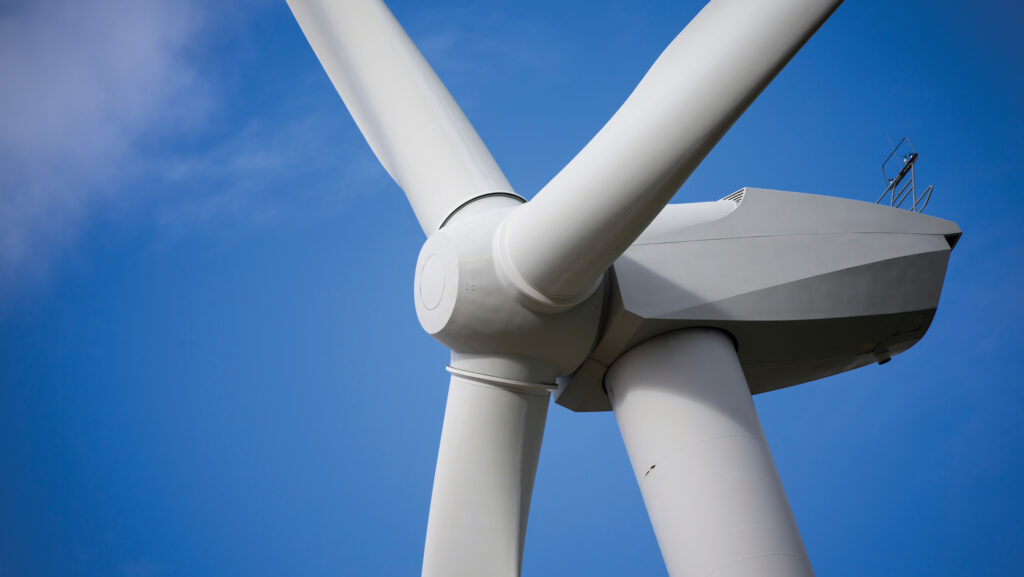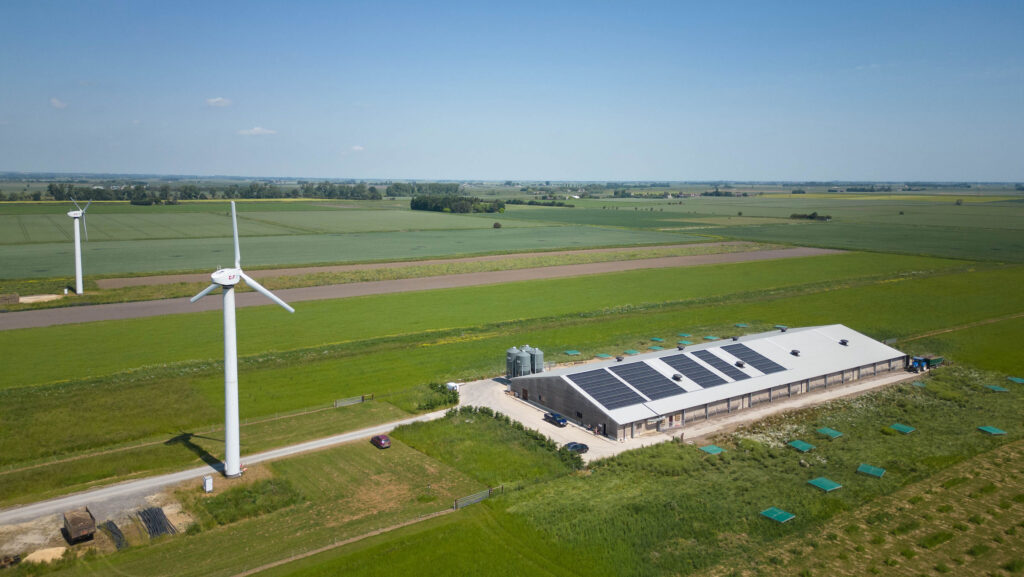Onshore wind turbines – prospects and advice for farmers
 © GNP
© GNP Chancellor Rachel Reeves recently lifted what was effectively a moratorium on new onshore wind power in England.
Interest in potential sites is warming up and while objections are still likely, turbines could be more acceptable to some local communities than large-scale solar projects, suggest renewable energy specialists.
See also: Farm wind turbine exclusivity agreements – what to watch out for
A route towards integrated land use
Compared to solar farms where agricultural activity is generally limited to grazing sheep around the arrays, turbines can be installed on land that remains fully productive, other than the average footprint for each turbine of 0.2ha, plus tracks.
Nick Green, head of energy and infrastructure at Savills, anticipates that some developers will consider switching all or part of potential solar schemes to wind to take advantage of the reduced land area required.
This will require a revised agreement with landowners.
Also, where a solar scheme is low in the queue in terms of planning or grid connection, a switch to onshore wind is a possibility for two reasons, says Nick.
First, planning authorities now have to take into account the cumulative effect of existing and planned solar projects in an area.
Second, the system for grid connection allocations has changed so that developers must demonstrate within a certain timescale that they have options in place to access enough land to develop the output included in their applications.
However, once environmental constraints and residential buffers are accounted for, the potential wind turbine areas in England are fairly constrained, says Nick, with initial mapping showing possibilities down the east coast from south of the North York Moors to the Cambridgeshire fens.
Grid applications for wind could be viewed positively because they will produce electricity when solar is not generating, he suggests.
Fewer players in wind market
The wind development market has fewer players than that for solar and battery sites.
These are a mix of those with large offshore wind interests and some which are interested only in onshore projects, mainly in Scotland and Wales.
“I think we will see less speculative development in wind than in the battery sector for example, but we may see some new entrants,” says Nick.
“A lot of developers have been looking quietly for a while in anticipation of the new arrangements, some dusting off old project plans with landowners.
“The new government has been quick out of the blocks on taking energy projects forward and there’s a lot more positivity and interest than during the previous government’s time.”
Lengthy process
However, the process from signing an agreement to operational turbines is a long one.
“Projects are still required to go through planning and the survey burden is higher for wind than solar. Putting this into context, it takes between seven and 10 years in Scotland for a project,” says Nick.
“Ultimately, access to the grid will determine the success of a project.”
Limited scope for large scale onshore developments
England is simply not as windy as Scotland and Wales. The number of locations where it is possible to build wind power at scale is very limited once landscapes within environmental designations are taken into account.
A buffer between residential areas and turbines is also a requirement. These relate to noise levels, requiring background data before installation, and typically range from 500m to 2km, although confirmation of the exact requirements is needed from the new government.
Two to three turbines most likely
For leased sites where a third party installs and operates the turbines, Nick sees two and three turbine schemes as the most likely.
However, he expects the main growth in onshore wind in England to be on farmer-owned sites with one or two turbines.
These may typically be 2MW models, although 500kW to 1MW models are still available and viable, he says.
“A big proportion of the costs of a turbine project are grid costs and the surveys required – in some cases two years’ worth of bird surveys.
“Broadly, the capital costs are about £1.4m/MW, with variations between sites driven by grid connection costs and the length of road needed to the turbine site.”
The most likely locations for farmer-owned turbines will be where there is a high demand for power on site, such as for large dairy, indoor pig and poultry enterprises, also for vegetable, dairy or other processing requirements.
“The challenge will be in offsetting on site what would otherwise be bought from the grid, or selling the energy produced to a nearby user,” he says. “Either way, this will deliver lower costs for the user than the retail market will offer.”
High electricity users such as data and logistics centres and industrial sites are likely to be buyers of farm-based power supplies through private wire agreements.
With business users currently paying about 25p/KWh for electricity and an export price from a turbine of around 7p/kWh if power was being sold to the grid, there is the scope for both the private wire customer and the turbine owner to benefit financially from such arrangements.
The wholesale price of electricity is showing a downward trend over the next 20 years, reflecting the expected growth in the proportion delivered from renewable sources.
This will make the economics of selling turbine-generated electricity to the grid more challenging, says Nick.
Refurbished turbines
Turbine manufacturers have in recent years concentrated on producing large scale kit for the offshore market, so the supply of smaller and medium sized turbines is limited.
However, a second-hand source is emerging as Scandinavian wind fields are being repowered with fewer, larger turbines and the original ones are refurbished for sale.
Scandinavian countries have a longer history of turbine use than the UK. These refurbished, warranted machines have had their mechanics upgraded and could be a useful source, says Nick, with 1.5-3MW models likely to be of most interest.

© Tim Scrivener
Length of agreements
The process for leased wind turbine sites is similar to those for solar in terms of the steps, including an exclusivity agreement (though not always), an option agreement and a lease.
“It’s important to have these checked to understand the rights and responsibilities of both parties,” says Nick.
Rental for leased sites
Wind sites differ to solar and battery projects in their rental structure, tending to include pre-agreed periodic reviews through the life of the lease, now typically 40 to 50 years.
Rents are generally linked directly to the installed capacity at so much per MW, then stepping up in, say, years 12 and 20, says Nick.
Landowners also receive a percentage of the revenue generated from the site, with reviews at the same intervals.
Typically an annual rent across the life of the project would be in the region of £10,000/MW, plus about a third more than this as a share of the revenue generated.
Developers will take an option on the site for up to 10 years.
This should include interim milestones such as a deadline by which a planning application is expected to be submitted, for example in the first three years, otherwise the landowner can terminate the agreement, says Nick.
After that initial period, the next three to five years might include the ability to extend the agreement on a period basis to a maximum of 10 years, but the developer needs to defend this ability with proof of progress.
If the option goes on for longer than the initial three years, then the annual payment would typically be topped up on an index-linked basis, he suggests.
“Then you would usually expect no further payment unless the developer is willing to pay a planning success fee, then the next payment would be a construction rent or disturbance fee when they enter the lease and start work on the site.”
Option payments on leased turbine sites vary, but might typically be £5,000 to £10,000 a year for the first three to five years and increasing to £10,000 a year after that, as a disincentive to the developer to take too long, says Nick.
Tax considerations
In the case of leased turbine sites, the main considerations under the current regime concern the income tax, inheritance tax (IHT) and capital gains tax (CGT) position relating to leased turbines, as well as those owned by farms or estates.
Careful preparation of business plans, cashflow forecasts and management accounts are the starting point to help with tax planning, says accountant Julie Butler of Butler & Co.
As there will be large distances between each turbine, a lot of business or farming activity can take place around them, which is a positive for IHT relief purposes, she says.
As with many diversified businesses, HMRC will be interested from an IHT perspective in whether the business qualifies as mainly trading or mainly holding investments. There is the potential for income from turbines to tip it into the latter.
How to value the turbine operation, whether leased or owned by the farm or estate, will be an issue at death or on the sale of the farm or turbine site.
While suggesting tax should not entirely drive decisions, Julie suggests that if it looks as if a proposed turbine operation may tip the balance away from being able to claim Agricultural Property Relief (APR) or Business Property Relief (BPR) from IHT, then consideration should be given to gifting the land on which turbines will sit before planning permission is granted.
Alternatively, if there are other non-trading assets, such as let cottages or other let property, it may be worth considering moving or gifting these into alternative ownership.
There are further options relating to turbines placed within woodland but, as with all other proposals, this needs tax advice specific to the circumstances.
It remains to be seen whether the forthcoming Budget alters the capital gains and IHT rates and reliefs.
UK onshore wind
The UK has 9,027 onshore wind turbines of 100kW or larger. These have an operational capacity of 15,107MW.
Source: Trade association – Renewable UK
